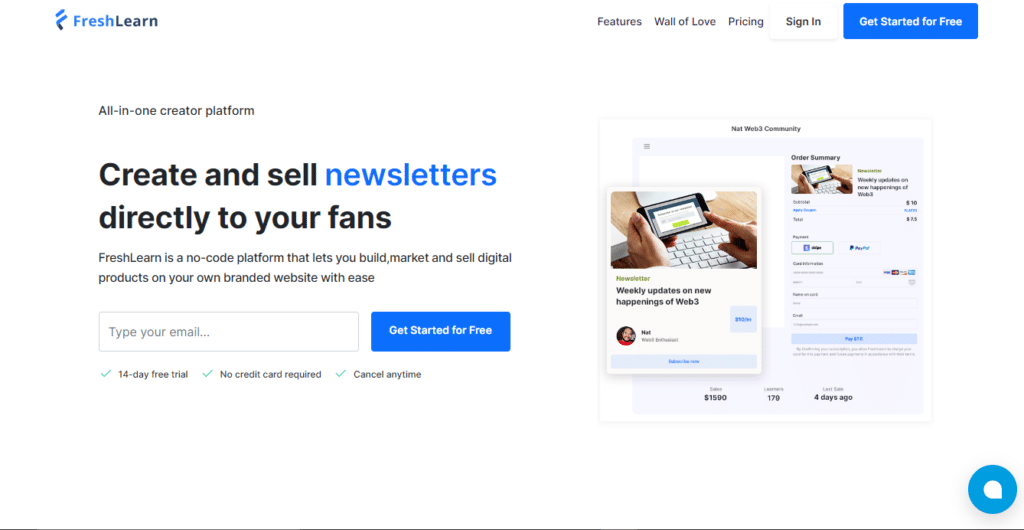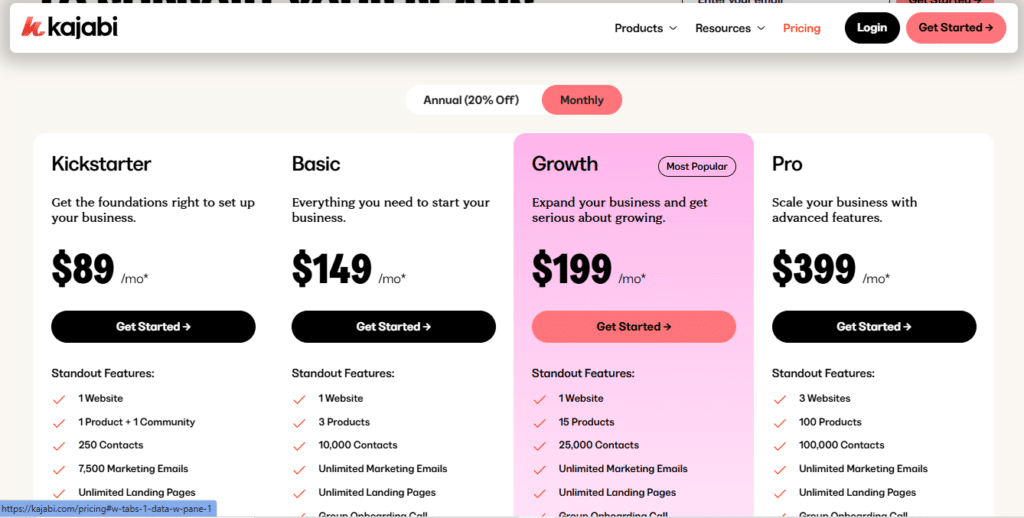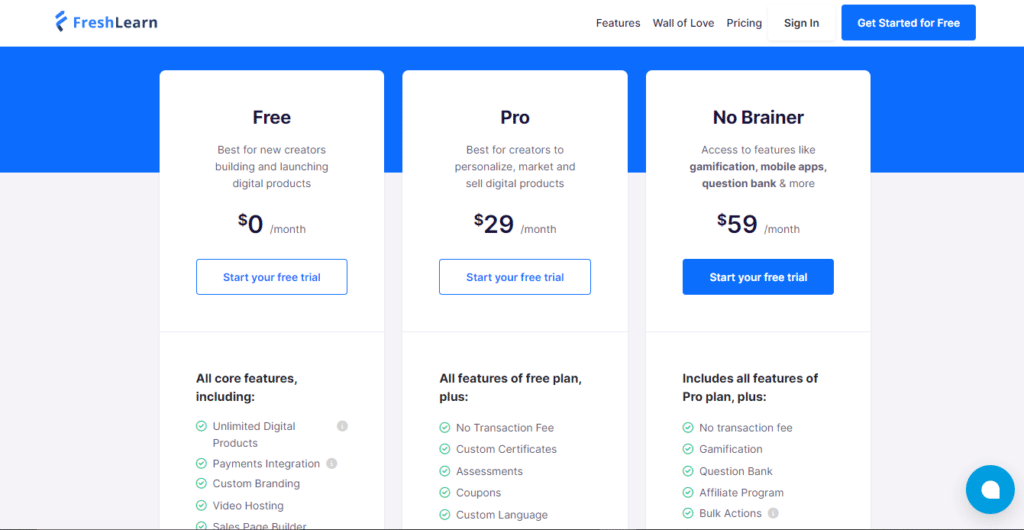Kajabi vs FreshLearn: A Comprehensive Platform Comparison
When building an online education business, choosing the right platform can significantly impact your growth potential, operational efficiency, and ultimately your success as a course creator. Kajabi and FreshLearn represent two different approaches to online course creation and digital business management, with Kajabi offering a comprehensive all-in-one platform while FreshLearn provides a more affordable, India-focused alternative. This detailed comparison will help you determine which platform better aligns with your specific needs, target audience, and business goals.
Overview of Kajabi

Kajabi is an all-in-one platform designed for entrepreneurs, creators, and educators looking to build and scale their online businesses. It provides a comprehensive ecosystem for creating, marketing, and selling digital products such as online courses, memberships, and coaching programs—all without relying on multiple third-party tools.
With its integrated website builder, email marketing automation, and sales pipeline creation, Kajabi simplifies the process of running a digital business. Even users with minimal technical knowledge can easily create high-quality content using pre-built templates and intuitive drag-and-drop functionality. By integrating powerful marketing tools with a robust learning management system (LMS), Kajabi enables businesses to efficiently attract, engage, and convert their audience while maximizing revenue—all from a single, user-friendly dashboard.
Key Features of Kajabi
- Course Creation Tools: Develop and deliver engaging online courses with video content, assessments, and drip-fed lessons.
- Website Builder: Design fully responsive, professional websites with built-in blogging capabilities and customizable templates.
- Sales Pipelines: Create automated funnels for lead generation, product launches, and webinars.
- Email Marketing Automation: Send personalized email campaigns, track engagement, and automate follow-ups.
- Membership Capabilities: Set up subscription-based memberships to generate recurring revenue.
- Payment Integration: Securely accept payments via Stripe and PayPal with zero additional transaction fees.
- Analytics Dashboard: Monitor revenue, track customer behavior, and measure marketing performance with in-depth insights.
- Community Features: Build an interactive member space for discussions, engagement, and networking.
Ideal User Base for Kajabi
- Course Creators: Educators and professionals looking to monetize their knowledge through online courses.
- Coaches & Consultants: Those offering coaching services, webinars, and one-on-one mentorship programs.
- Membership Site Owners: Entrepreneurs looking to create thriving subscription-based communities.
- Digital Entrepreneurs: Individuals managing multiple digital products and looking for a streamlined business solution.
Overview of FreshLearn

FreshLearn is an emerging course creation and digital product platform designed with a focus on accessibility, affordability, and regional payment support, particularly for creators in India and other developing markets. Founded in 2020, FreshLearn aims to democratize online education by providing essential course creation and selling tools at price points accessible to creators who find global platforms prohibitively expensive.
Unlike comprehensive all-in-one platforms with premium pricing, FreshLearn concentrates on delivering core functionality for course creation, student management, and sales without the extensive marketing features or advanced customization options found in more expensive platforms. The platform particularly excels in supporting regional payment methods, local currency pricing, and market-specific features that global platforms often overlook.
What sets FreshLearn apart is its practical approach to essential needs for course creators in developing markets, offering a balanced feature set with appropriate regional optimizations at significantly lower price points than international platforms. While not as feature-rich as premium all-in-one solutions, FreshLearn provides the fundamental tools needed to create, sell, and deliver online courses without the financial barrier that often prevents creators in emerging markets from launching their digital education businesses.
Key Features of FreshLearn
- Course Builder: Create and organize online courses with modules, lessons, and various content types.
- Regional Payment Support: Accept payments in local currencies with region-specific payment methods.
- Live Class Integration: Host and record live sessions through Zoom and other video conferencing tools.
- Basic Marketing Tools: Create coupons, offers, and simple marketing pages for course promotion.
- Student Management: Track enrollment, progress, and engagement across courses and programs.
- Mobile Responsiveness: Deliver content optimized for the mobile-first audiences common in developing markets.
- Affiliate System: Enable course promotion through basic affiliate and referral programs.
- Localized Support: Access customer service familiar with regional challenges and requirements.
Ideal User Base for FreshLearn
- Emerging Market Educators: Course creators in India, Southeast Asia, and other developing regions.
- Budget-Conscious Creators: Those seeking affordable alternatives to premium international platforms.
- Regional Content Creators: Educators creating courses in local languages for specific regional audiences.
- Side-Hustle Entrepreneurs: Professionals starting course businesses alongside primary employment.
- New Course Creators: First-time educators testing the online course market without significant investment.
Core Functionalities Comparison
Understanding how Kajabi and FreshLearn compare across key functional areas is essential for determining which platform better aligns with your specific business needs and target audience. This section provides a detailed analysis of their capabilities in several critical domains.
1. Course Creation and Content Delivery
Kajabi offers robust course creation tools with flexible content organization options. Courses can be structured into products, categories, modules, and lessons with support for various media types including video, audio, text, quizzes, and downloadable resources. The platform provides features like drip content scheduling, prerequisite lessons, and completion certificates. Kajabi's course player delivers a polished, distraction-free learning experience with progress tracking and mobile responsiveness. The platform excels in creating professional educational experiences with diverse assessment options and structured learning paths.
FreshLearn provides essential course creation functionality with a more streamlined approach. The platform supports organizing content into modules and lessons with standard media types like video, text, and downloadable files. While lacking some of Kajabi's advanced features, FreshLearn offers the fundamental tools needed to create structured courses with basic progress tracking and completion management. The platform particularly focuses on optimizing video delivery for regions with bandwidth constraints—a significant consideration for many developing markets. For creators seeking essential course functionality without complex features, FreshLearn's straightforward approach provides a practical solution despite fewer advanced options.
2. Marketing and Sales Capabilities
Kajabi excels in marketing with comprehensive tools covering the entire customer journey. The platform includes landing page builders, email marketing automation, sales funnels (“Pipelines”), and checkout optimization features. Kajabi's marketing strength lies in its integrated approach, with pre-built pipelines for scenarios like lead magnets, webinars, and product launches. The platform supports sophisticated marketing techniques like upsells, abandoned cart recovery, and targeted automation based on user behavior. For educators focusing on building sophisticated marketing systems alongside their courses, Kajabi's integrated marketing suite eliminates the need for multiple marketing tools.
FreshLearn offers more basic marketing functionality focused on essential needs rather than advanced automation. The platform provides simple landing pages, course showcase options, and promotional tools like coupons and limited-time offers. FreshLearn lacks the depth of Kajabi's marketing capabilities, with no built-in email marketing, complex sales funnels, or advanced automation features. Instead, the platform concentrates on optimizing the core selling process with regionally appropriate payment methods and pricing options. For creators in developing markets who prioritize accessibility over marketing sophistication, FreshLearn's focused approach may align better with their immediate needs despite offering fewer marketing features.
3. Payment Processing and Regional Optimization
Kajabi integrates with major international payment processors like Stripe and PayPal, supporting standard payment methods in developed markets. The platform handles one-time payments, subscriptions, and payment plans with flexible pricing options. While functional for global creators with access to mainstream payment processors, Kajabi's payment options can present challenges for educators in regions where these processors have limited presence or where regional payment methods dominate. The platform primarily supports USD and other major currencies, with limited optimization for regional pricing strategies or local payment preferences.
FreshLearn distinguishes itself with region-specific payment processing designed for markets where international processors have limited reach. The platform supports local payment methods popular in India and other developing regions, including UPI, domestic cards, and region-specific digital wallets. FreshLearn handles multi-currency pricing with appropriate tax handling for different jurisdictions. The platform's payment infrastructure is specifically optimized for regions often underserved by global platforms, with features like installment options appropriate for emerging market consumers. For creators targeting audiences in developing markets, FreshLearn's regionalized payment capabilities offer significant advantages over platforms designed primarily for Western markets.
4. Pricing and Affordability
Kajabi operates on a premium pricing model reflecting its comprehensive feature set. With plans starting at $149 monthly, Kajabi represents a significant investment for creators, particularly those in regions with weaker currency values relative to the USD. While offering excellent value for established businesses in developed markets, Kajabi's pricing can be prohibitive for creators in emerging economies where equivalent local purchasing power would make the platform extraordinarily expensive in relative terms. The investment required may present a substantial barrier to entry for many potential educators in developing markets, regardless of the platform's quality and capabilities.
FreshLearn offers dramatically more accessible pricing designed specifically for creators in developing markets. With plans starting around $20-30 monthly (when converted from Indian rupees), FreshLearn provides core functionality at approximately 15-20% of Kajabi's entry price. This pricing strategy reflects both the more focused feature set and a deliberate effort to make course creation accessible to educators in regions with different economic realities. For creators in developing markets or those just testing the waters of online education, FreshLearn's affordable entry point may be the deciding factor despite offering fewer advanced features than premium platforms.
5. Community and Student Engagement
Kajabi includes built-in community features through its “Community” product, which provides discussion forums, member interaction, and content sharing. Students can engage in conversations, ask questions, and connect with instructors through a social media-style interface. The platform supports creating engaged learning environments with topic organization, moderation tools, and direct messaging. While not as sophisticated as dedicated community platforms, Kajabi's community features provide solid functionality for building student engagement directly within the course environment.
FreshLearn offers more basic community functionality focused on essential interaction rather than comprehensive engagement features. The platform provides simple discussion capabilities, comment systems on lessons, and basic Q&A functionality between students and instructors. FreshLearn lacks the depth of Kajabi's community tools but delivers fundamental interaction features sufficient for straightforward courses. For many creators, particularly those teaching more technical or information-focused subjects where community interaction is supplementary rather than central, FreshLearn's simplified approach may be adequate despite its limitations compared to more comprehensive platforms.
6. Support and Regional Relevance
Kajabi provides professional support through standard channels including documentation, knowledge base, email support, and live chat for higher-tier plans. The platform's support materials and interfaces are primarily in English, with limited localization for other regions or languages. Support hours primarily align with North American time zones, which may create challenges for users in significantly different time zones. While offering quality support, Kajabi's assistance model is designed with its primary markets in mind rather than providing specialized guidance for regional challenges or market-specific implementation questions.
FreshLearn differentiates itself with support specifically tailored to its core regional markets. The platform offers assistance familiar with local business practices, payment systems, and market expectations in India and similar regions. Support materials and interfaces are available in multiple regional languages alongside English, creating greater accessibility for non-English-speaking creators. Support hours align with Asian time zones, providing more immediate assistance for users in these regions. For creators in FreshLearn's target markets, this regionally relevant support can prove more valuable than more comprehensive but less contextually appropriate assistance from global platforms.
Pricing Comparison: Kajabi vs FreshLearn
Understanding the pricing structures of both platforms is essential for making a cost-effective decision based on your business requirements and market context.
Kajabi Pricing Plans

Kajabi offers several tiered pricing options designed to accommodate businesses at different growth stages:
1. Basic Plan ($149/month)
The Basic Plan is ideal for newcomers to online business. It includes essential tools to get started, such as:
- Support for 3 products and 3 pipelines.
- 10,000 contacts and 1,000 active members.
- Basic marketing automation.
- Unlimited landing pages and emails.
2. Growth Plan ($199/month)
The Growth Plan is perfect for scaling businesses that require advanced marketing features and greater resource limits:
- Support for 15 products and 15 pipelines.
- 25,000 contacts and 10,000 active members.
- Advanced automation and affiliate program management.
- Removal of Kajabi branding for a more customized experience.
3. Pro Plan ($399/month)
The Pro Plan is designed for established businesses with high-volume requirements:
- Support for 100 products and 100 pipelines.
- 100,000 contacts and 20,000 active members.
- Priority support and custom branding capabilities.
- Advanced features such as code editor access for deeper customization.
4. Kickstarter Plan ($89/month)
This budget-friendly option is ideal for beginners who want to test Kajabi's core functionalities before committing to higher-tier plans:
- Limited products and pipelines.
- Basic features for course creation and email marketing.
All Kajabi plans include a 14-day free trial, and users can save approximately 20% by opting for annual billing.
FreshLearn Pricing Plans

FreshLearn offers more accessible pricing with plans in USD:
1. Free Plan ($0)
The Free Plan provides essential course creation and selling features:
- Up to 3 courses
- Unlimited students
- Basic course builder
- Standard payment processing
- Student management
- Course coupons and offers
- Email notifications
- Basic analytics
- Standard support
2. Pro Plan ($29/month)
The Pro Plan adds more capabilities for growing course businesses:
- Up to 10 courses
- Unlimited students
- Enhanced course features
- Multiple payment options
- Basic affiliate program
- Custom domain
- Live class integration
- Priority support
- Advanced analytics
3. No Brainer Plan ($59/month)
The No Brainer Plan supports established educators with advanced needs:
- Unlimited courses
- Unlimited students
- Complete course capabilities
- All payment methods
- Advanced affiliate system
- White-labeling options
- API access
- Priority support with dedicated manager
- Comprehensive analytics
- Custom integrations
FreshLearn also offers significant discounts for annual billing, typically reducing effective monthly costs by 20-25%. The platform provides a 14-day free trial for all plans and occasionally offers special pricing for educational institutions or nonprofit organizations.
When comparing pricing, it's essential to consider not just the nominal cost but the relative affordability within different economic contexts. FreshLearn's Basic Plan at approximately $20/month represents a dramatically more accessible entry point for creators in developing markets compared to Kajabi's $149/month Basic Plan or even $89/month Kickstarter Plan.
Making the Right Choice for Your Business
Choosing between Kajabi and FreshLearn ultimately depends on your specific needs, target audience, and business context. Here's guidance to help you make an informed decision:
Choose Kajabi if:
- You're operating primarily in developed markets like North America or Europe
- You need comprehensive marketing tools including email automation and sales funnels
- You're building a sophisticated digital business with multiple products and revenue streams
- Your business model requires advanced features like pipelines, assessments, and detailed analytics
- You have sufficient budget to invest in a premium all-in-one platform
- Your audience primarily uses mainstream international payment methods
- You prioritize platform polish and comprehensive features over regional specialization
- You're building a long-term business where advanced capabilities will justify the higher investment
Choose FreshLearn if:
- You're operating primarily in India, Southeast Asia, or similar developing markets
- You're working with a limited budget and need an affordable entry point
- Your audience prefers regional payment methods not well supported by global platforms
- You're just starting your course business and want to test the market without major investment
- You prioritize regional relevance and local market optimization over comprehensive features
- Your courses are delivered in regional languages to local audiences
- You need support familiar with your specific market context and challenges
- You're building a business where accessibility and regional fit outweigh advanced capabilities
Regional Context Considerations
The decision between these platforms often hinges on regional factors that significantly impact business operations:
- Economic Context: In many developing markets, Kajabi's $149/month Basic Plan could represent a substantial portion of monthly income for new educators, making FreshLearn's $20/month entry point not just preferable but necessary for market entry.
- Payment Ecosystem: Regions like India have distinct payment preferences (UPI, local wallets, domestic cards) that may not be well supported by global platforms designed primarily for markets where credit cards and PayPal dominate.
- Audience Expectations: Students in different regions may have distinct expectations regarding course presentation, pricing models, and interaction patterns that regionally-focused platforms better understand and accommodate.
- Language and Support: Non-English speaking creators may find significant value in platforms offering interfaces and support in their primary language rather than English-only systems.
Final Considerations
When making your decision, consider these additional factors:
Market Testing vs. Scaling:
Many creators find value in starting with more affordable, regionally relevant platforms like FreshLearn to test their course concepts and build initial audience, then potentially migrating to more comprehensive platforms like Kajabi as their business grows and justifies the additional investment.
Feature Requirements vs. Budget Reality:
Candidly assess which features are truly essential for your specific teaching model and business approach. Many creators discover they need only a fraction of the features offered by premium platforms, making more focused alternatives viable despite fewer advanced capabilities.
Long-Term Growth Strategy:
Consider your 2-3 year vision for your education business. Platform migrations become increasingly challenging as your student base grows, so selecting a platform that can accommodate your projected growth is important for sustainability.
Both platforms represent valid approaches to online education, but they serve different markets and business contexts. By carefully evaluating your specific needs, audience characteristics, and regional factors, you can select the platform that provides the best foundation for your unique educational business.